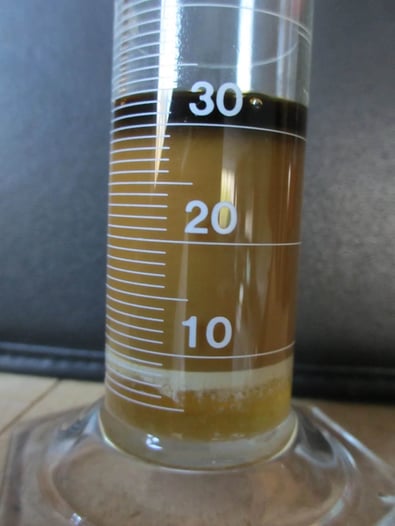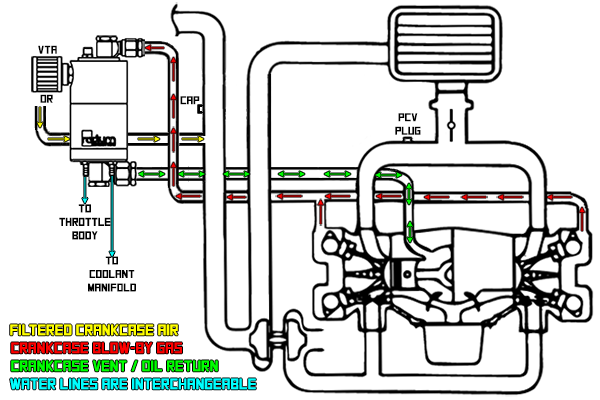Does the Subaru WRX and STI Really Need a Catch Can?
November 8th, 2023 | 4 min read
By Alan Jackson

A catch can is a device installed between the engine's crankcase and the intake system. It “catches” all the oil vapor that passes from the crankcase back into the intake system where the crankcase vents. This oil vapor has a low octane rating and also coats the walls of the entire intake tract and builds up over time. When the junk from the crankcase makes it's way into the cylinders, it can cause detonation and reduce the performance of the engine.
Do you need one on your Subaru WRX or STI? Catch cans don't come on any modern cars from the factory so why do you need to add one? It's up to you in the end, but hopefully I can explain a few things that may help you make a more educated decision.
Technically, there are two different ways/locations you can install a catch can on the WRX and STI (and most cars that I know of), the PCV and the CCV. The PCV is the connection between the crankcase and the intake manifold and the CCV is the connection between the cylinder head and the pre-turbo intake system.
How the Crankcase Ventilation System Works
The factory system has a couple points which use engine vacuum as a way to help remove positive crankcase pressure. Pressure behind the pistons works against the engines efficiency and power making potential. So removing this pressure is akin to removing parasitic loss. If you couldn't remove the pressure from the crankcase, it would also wreak havoc on seals and gaskets that assist in oil flow back to the pan. Additionally, OEM's can't vent it to the atmosphere as it would cause an emissions issue and make your entire car stink too.
The pressure being relieved contains oil vapor and fuel vapor, and other inert gases that when sucked back into the intake system, pollute the clean air and degrade the vehicle's performance. They reduce power and efficiency and it gets worse over time because they coat the walls of everything in the intake system including your turbo, intercooler, throttle, intake manifold, and valves.
 (1) Intake (2) PCV Valve (3) Intake Manifold (4) Crankcase
(1) Intake (2) PCV Valve (3) Intake Manifold (4) Crankcase
On the WRX and STI, you have two points where the valve cover (one on each bank) is vented back to the inlet pipe. You have another point which contains a PCV valve and this is vented to the intake manifold. Under boost, the PCV valve closes so as not to introduce boost to the crankcase. At part throttle, or any time the manifold is in a vacuum state, it will be open and allowing these blow-by gasses to enter the manifold. The vents at the valve covers are open all the time and allow blow-by gasses to enter pre-turbo during wide open throttle (WOT) operation when the PCV system is closed.
 What are blow-by gases?
What are blow-by gases?
Your catch can doesn't just catch oil... "Blow-by" is a mixture of contaminates that make their way past the piston rings and combine with oil vapor in the crankcase. This gas has an octane rating of about 40 and when it finds its way back into the combustion side of the cylinder, it can reduce the overall octane of the fuel and allow for detonation to occur. As mentioned before, they don't all make their way to the cylinder. They build up along the walls of the intake.
Will you miss it when it's gone?
No, you won’t. And neither will your engine.
To reduce the influence of blow-by matter, you need a catch can or an air-oil separator (AOS) that will remove them from the system. These devices work to separate the oil vapor and everything else that makes up blow-by from the air and allow it to settle in the can or flow back into the crankcase as a liquid rather than a vapor.
When this is removed from the system, you will be able to fit more clean air in the cylinders and in case you didn’t know, clean air has more power potential than dirty air. Your engine will run cleaner and have less working against its ability to make power.
This is especially helpful on Direct Injected (DI) cars like the FA20DIT powered WRX. Since the injectors are in the head, these blow-by gases will coat the valves and cause build up over time. This will drastically reduce performance.
The Benefits of an AOS (Air/Oil Separator)
An air-oil separator is a great device that makes running a catch can a lot easier. The AOS catches everything that a catch can does and you never need to worry about dumping it out. The downside to this is that you are dumping all this fuel/oil/blow-by gas mixture back into the crank case where it can mix with and slowly dilute your good oil. However, this is rarely an issue on cars where regular 3,000 mile oil changes are performed.
 This diagram from Radium Engineering shows their AOS in action.
This diagram from Radium Engineering shows their AOS in action.
Another benefit to the AOS is that one AOS can often do the work of two catch cans. Installation can be easier than a two catch can setup and maintenance on it is negligible compared to stock.
The Benefits of a Catch Can
A catch can catches and holds. Because of this, it will need to be drained regularly. It's usually a good practice to check it while doing oil changes. In theory, it shouldn't be holding a ton if you're checking it at oil change intervals. A super healthy engine doesn't have a ton of blow-by contaminants. With that said, the contents of the catch can might help reveal how your engine is doing. If it fills up quickly and/or with severely dirty material, this can be a warning sign to larger issues. Since the catch can doesn’t let its contents drain back into the pan, you don’t have to worry about oil contamination.
 This diagram from Radium Engineering shows their dual catch can setup in action.
This diagram from Radium Engineering shows their dual catch can setup in action.
Catch cans allow the PCV system to continue functioning exactly as stock since they simply intersect the points from the crankcase back to the intake tract. However, to maintain this factory like operation, you will need to run two separate cans. One for the valve covers, and one for the PCV system as this will maintain the OE designed flow through the crankcase.
Going back to the original question, again, this is an optional modification and technically not needed to operate a high performance car. But if the point of a build is to perform, this could be considered paramount in achieving a higher level of performance both immediately and from a reliability standpoint. You will almost never see a well built race car in the pits without this functionality.
This post was originally published in January, 2017 but has been updated to reflect current parts and accurate information!
Topics: